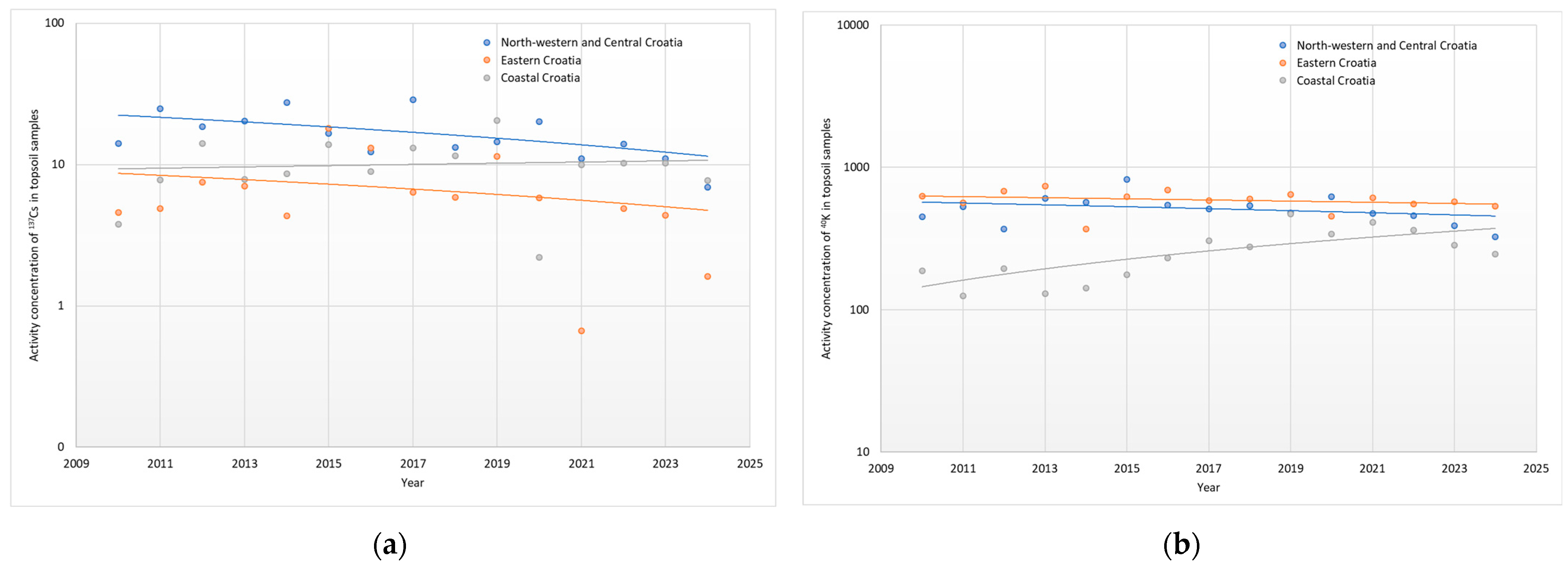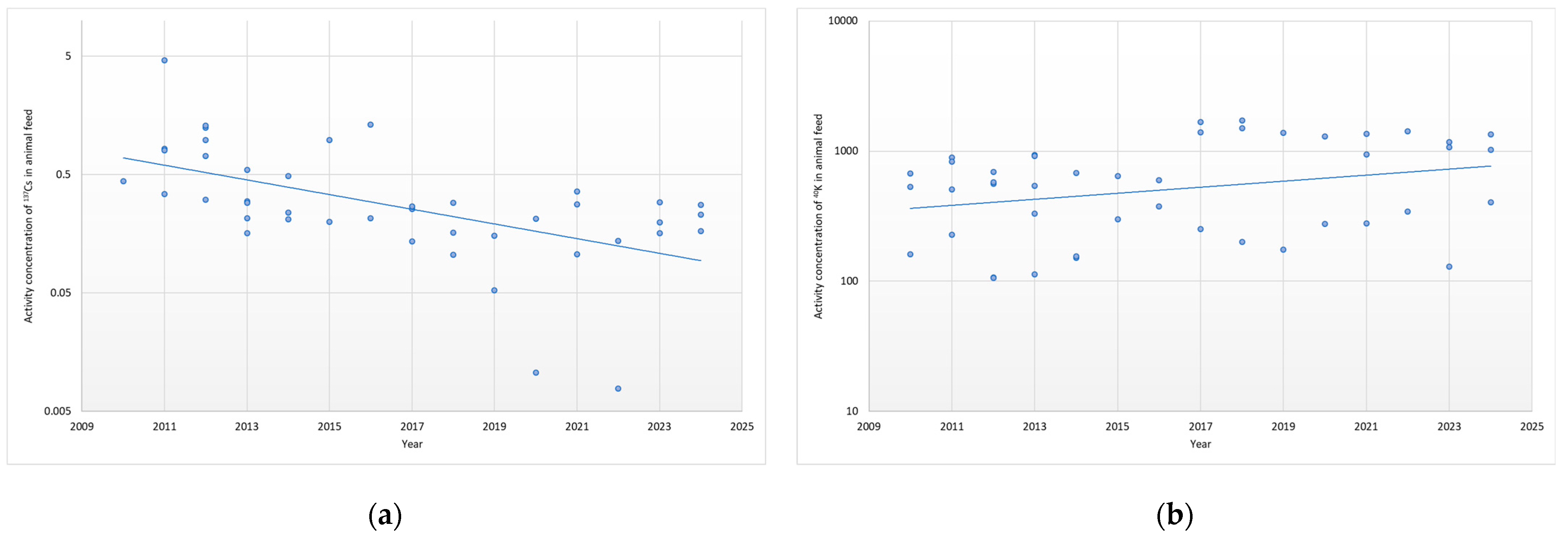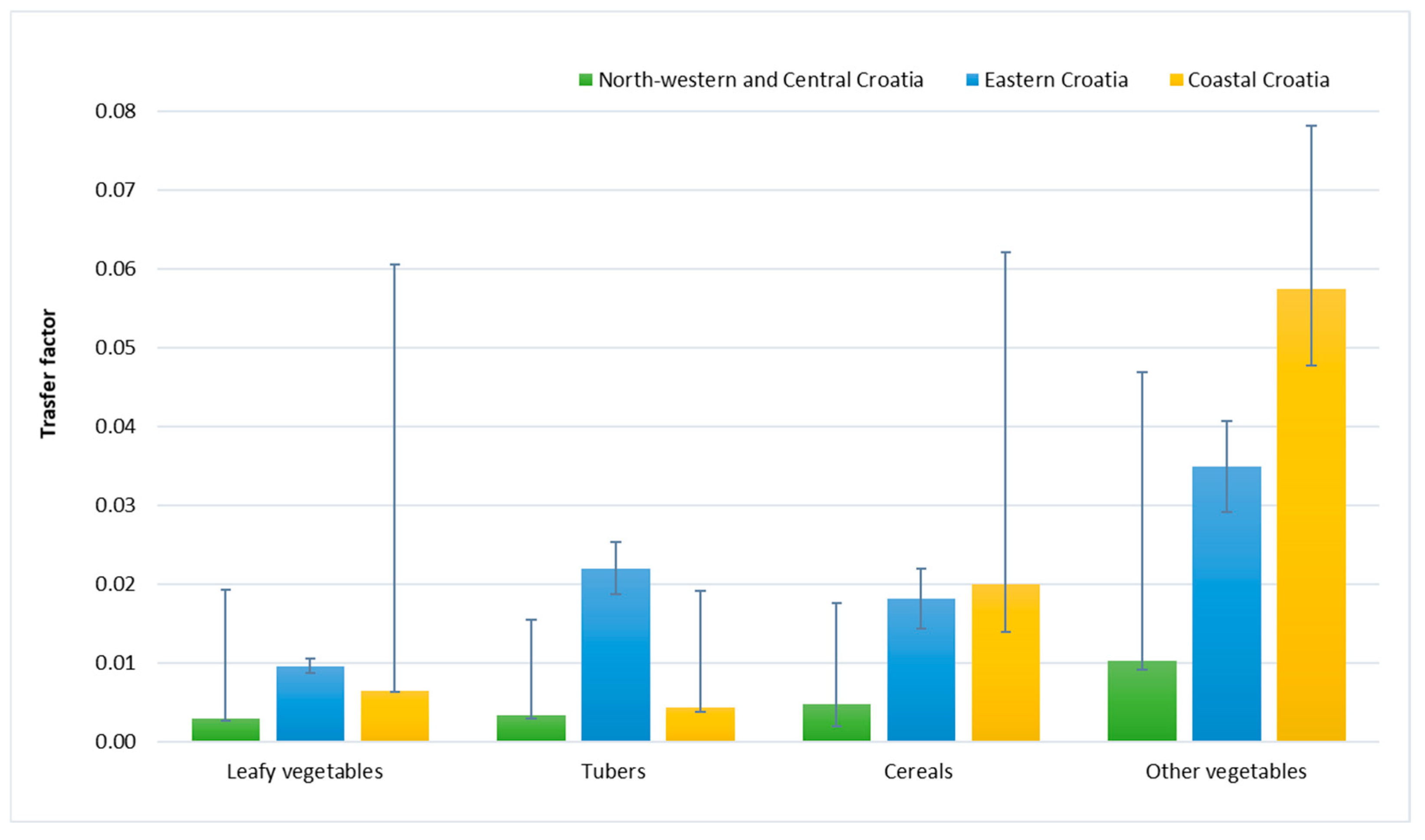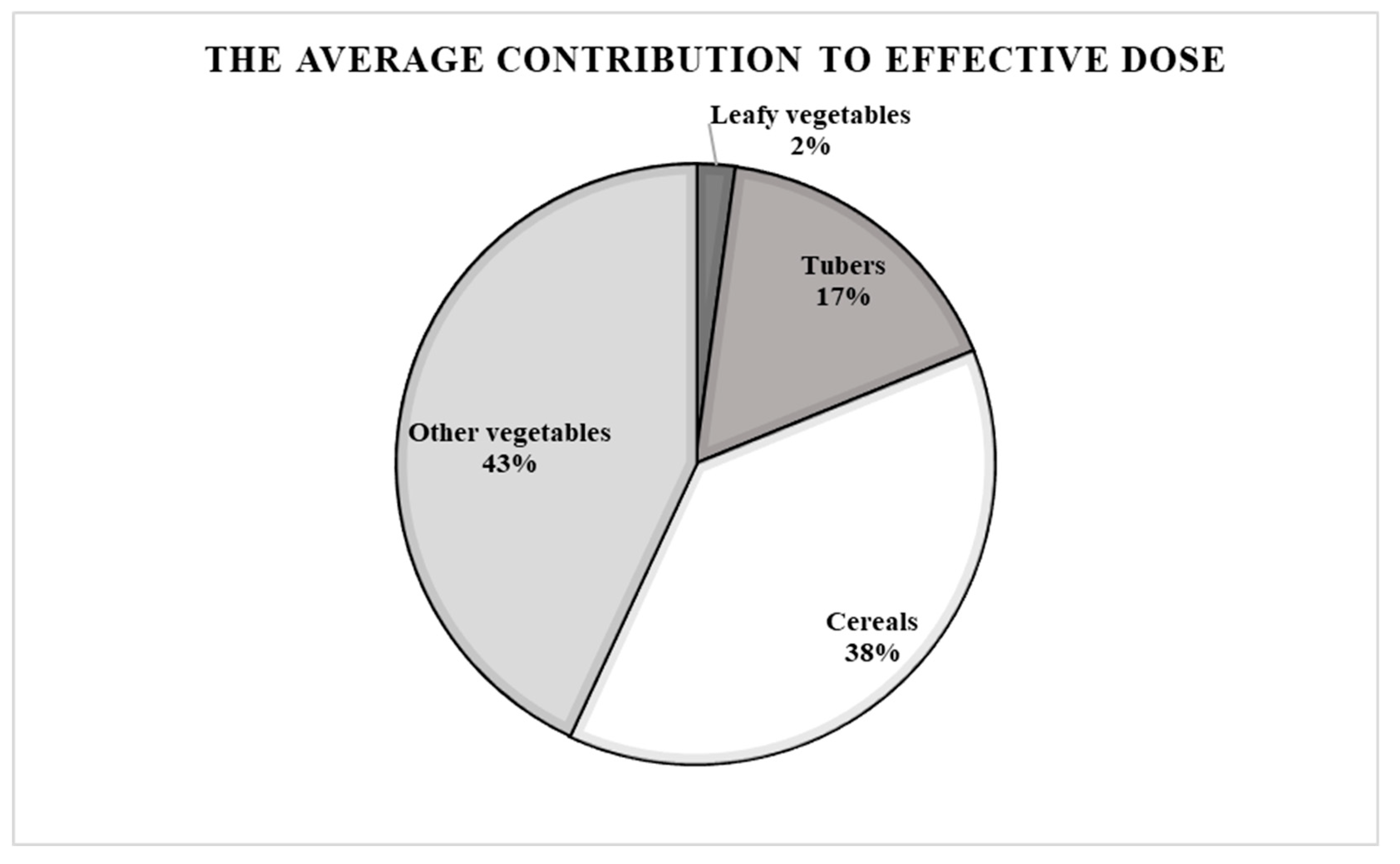Assessment of 137Cs and 40K Transfer Factors in Croatian Agricultural Systems and Implications for Food Safety
Abstract
1. Introduction
2. Materials and Methods
2.1. Sampling and Laboratory Analysis
2.2. Transfer Factors
2.3. Annual Effective Dose Calculations
3. Results and Discussion
3.1. Activity Concentrations of 137Cs and 40K in Food, Animal Feed and Soil
3.2. Transfer Factors from Soil to Plant
3.3. Effective Dose from Ingestion
4. Conclusions
Author Contributions
Funding
Data Availability Statement
Acknowledgments
Conflicts of Interest
References
- Abbasi, A.; Mirekhtiary, F. 137Cs and 40K concentration ratios (CRs) in annual and perennial plants in the Caspian coast. Mar. Pollut. Bull. 2019, 146, 671–677. [Google Scholar] [CrossRef] [PubMed]
- Petrinec, B.; Bituh, T.; Franić, Z.; Zauner, B.; Babić, D. Results of Environmental Radioactivity Measurements in the Republic of Croatia, 2024: Annual Reports 2022–2023; Institute for Medical Research and Occupational Health, Radiation Protection Division: Zagreb, Croatia, 2024. (In Croatian) [Google Scholar]
- Zhu, Y.-G.; Smolders, E. Plant uptake of radiocaesium: A review of mechanisms, regulation and application. J. Exp. Bot. 2000, 51, 1635–1645. [Google Scholar] [CrossRef] [PubMed]
- Official Journal of the European Union. Commission Implementing Regulation (EU) 2020/1158 of 5 August 2020 on the Conditions Governing Imports of Food and Feed Originating in Third Countries Following the Accident at the Chornobyl Nuclear Power Station. Available online: https://eur-lex.europa.eu/legal-content/EN/TXT/PDF/?uri=CELEX:32020R1158 (accessed on 17 April 2025).
- Shaw, G.; Bell, J.N.B. Competitive effects of potassium and ammonium on caesium uptake kinetics in wheat. J. Environ. Radioact. 1991, 13, 283–296. [Google Scholar] [CrossRef]
- Vinichuk, M.; Taylor, A.F.S.; Rosen, K.; Johanson, K.J. Accumulation of potassium, rubidium and caesium (133Cs and 137Cs) in various fractions of soil and fungi in a Swedish forest. Sci. Total Environ. 2010, 408, 2543–2548. [Google Scholar] [CrossRef] [PubMed]
- Roca, M.C.; Vallejo, V.R. Effect of soil potassium and calcium on caesium and strontium uptake by plant roots. J. Environ. Radioact. 1995, 28, 141–159. [Google Scholar] [CrossRef]
- Official Gazette. Pravilnik o Zaštiti Poljoprivrednog Zemljišta od Onečišćenja, Official Gazette 71/2019. 2019. Available online: http://narodne-novine.nn.hr/clanci/sluzbeni/2019_07_71_1507.html (accessed on 21 April 2025). (In Croatian).
- Mate, B.; Sobiech-Matura, K.; Altzitzoglou, T. Radionuclide monitoring in foodstuff: Overview of the current implementation in the EU countries. J. Radioanal. Nucl. Chem. 2015, 303, 2547–2552. [Google Scholar] [CrossRef] [PubMed]
- Merz, S.; Steinhauser, G.; Hamada, N. Anthropogenic Radionuclides in Japanese Food: Environmental and Legal Implications, Environ. Sci. Technol. 2013, 47, 1248–1256. [Google Scholar] [CrossRef] [PubMed]
- Ilievski, T.; Skoko, B.; Karanović, G.; Grahek, Ž.; Magdić Košiček, K.; Coha, I.; Pavičić-Hamer, D.; Tucaković, I. Radioactivity in food crops from the family farms in Croatia with ingestion dose assessment. Food Control 2025, 167, 110805. [Google Scholar] [CrossRef]
- IAEA—International Atomic Energy Agency. IAEA-TRS-472 Handbook of Parameter Values for the Prediction of Radionuclide Transfer in Terrestrial and Freshwater Environments. 2010. Available online: https://www.iaea.org/publications/8201/handbook-of-parameter-values-for-the-prediction-of-radionuclide-transfer-in-terrestrial-and-freshwater-environments (accessed on 17 April 2025).
- Carini, F. Radionuclide transfer from soil to fruit. J. Environ. Radioact. 2001, 52, 237–279. [Google Scholar] [CrossRef] [PubMed]
- Schuller, P.; Bunzl, K.; Voigt, G.; Krarup, A.; Castillo, A. Seasonal variation of the radiocaesium transfer soil-to-Swiss chard (Beta vulgaris var. cicla L.) in allophanic soils from the Lake Region, Chile. J. Environ. Radioact. 2005, 78, 21–33. [Google Scholar] [CrossRef] [PubMed]
- IAEA—International Atomic Energy Agency. Soil Sampling for Environmental Contaminants; IAEA: Vienna, Austria, 2004; Available online: https://www.iaea.org/publications/7113/soil-sampling-for-environmental-contaminants (accessed on 16 April 2025).
- Vera Tome, F.; Blanco Rodríguez, M.P.; Lozano, J.C. Soil-to-plant transfer factors for natural radionuclides and stable elements in a Mediterranean area. J. Environ. Radioact. 2003, 65, 161–175. [Google Scholar] [CrossRef] [PubMed]
- ISO/IEC 17025:2017; General Requirements for the Competence of Testing and Calibration Laboratories. International Organization for Standardization: Geneva, Switzerland, 2017.
- Official Gazette. The Ordinance on Dose Limits, Recommended Dose Limits, and Assessment of Personal Doses. Official Gazette 38/2018; 8/2022. Available online: https://narodne-novine.nn.hr/clanci/sluzbeni/2018_04_38_739.html and https://narodne-novine.nn.hr/clanci/sluzbeni/2022_01_8_74.html (accessed on 17 April 2025). (In Croatian).
- IAEA—International Atomic Energy Agency. BSS—Radiation Protection and Safety of Radiation Sources: International Basic Safety Standards (General Safety Requirements Part 3). Available online: https://www.iaea.org/publications/8930/radiation-protection-and-safety-of-radiation-sources-international-basic-safety-standards (accessed on 18 April 2025).
- Franić, Z.; Marović, G.; Lokobauer, N. Radiocaesium activity concentrations in wheat grains in the Republic of Croatia for 1965–2003 and dose assessment. Environ. Monit. Assess. 2006, 115, 51–67. [Google Scholar] [CrossRef] [PubMed]
- Zgorelec, Ž.; Šoštarić, M.; Babić, D.; Šestak, I.; Mesić, M.; Perčin, A.; Petrinec, B. Effects of fertilisation on radionuclide uptake by maize from an acidic soil in northwestern Croatia. Soil. Tillage Res. 2021, 212, 105030. [Google Scholar] [CrossRef]
- Zdenko, F.; Petrinec, B.; Marović, G.; Franić, Z. Radiocaesium activity concentrations in potatoes in croatia after the chernobyl accident and dose assessment. J. Environ. Sci. Heal. Part B Pestic. Food Contam. Agric. Wastes 2007, 42, 211–217. [Google Scholar] [CrossRef][Green Version]
- Mück, K. Long-term effective decrease of cesium concentration in foodstuffs after nuclear fallout. Health Phys. 1997, 5, 653–673. [Google Scholar] [CrossRef] [PubMed]
- Šoštarić, M.; Petrinec, B.; Avdić, M.; Petroci, L.; Kovačić, M.; Zgorelec, Ž.; Skoko, B.; Bituh, T.; Senčar, J.; Branica, G.; et al. Radioactivity of soil in Croatia II: 137Cs, 40K, and absorbed dose rate. Arh. Hig. Rada Toksikol. 2021, 72, 15–22. [Google Scholar] [CrossRef] [PubMed]
- Koch-Steindl, H.; Pröhl, G. Considerations on the behaviour of long-lived radionuclides in the soil. Radiat. Environ. Biophys. 2001, 40, 93–104. [Google Scholar] [CrossRef] [PubMed]
- Ehlken, S.; Kirchner, G. Environmental processes affecting plant root uptake of radioactive trace elements and variability of transfer factor data: A review. J. Environ. Radioact. 2002, 58, 97–112. [Google Scholar] [CrossRef] [PubMed]
- Waegeneers, N.; Sauras-Year, T.; Thiry, Y.; Vallejo, V.R.; Smolders, E.; Madoz-Escande, C.; Brechignac, F. Plant uptake of radiocaesium from artificially contaminated soil monoliths covering major European soil types. J. Environ. Radioact. 2009, 100, 439–444. [Google Scholar] [CrossRef] [PubMed]
- Semioshkina, N.; Voigt, G. Soil-Plant transfer of radionuclides in arid environments. J. Environ. Radioact. 2021, 237, 106692. [Google Scholar] [CrossRef] [PubMed]
- ICRP—International Commission on Radiological Protection. Annals of the ICRP Publication 103: The 2007 Recommendations of the International Commission on Radiological Protection; Elsevier: Oxford, UK, 2007; pp. 1–332. Available online: https://www.icrp.org/publication.asp?id=ICRP%20Publication%20103 (accessed on 24 April 2025).




| Region | Foodstuff Group (Number of Samples) | Activity Concentration (Bq/kg) | ||
|---|---|---|---|---|
| 137Cs | 40K | |||
| North-western and Central Croatia | Leafy vegetables (42) | Mean | 0.04 ± 0.05 | 83 ± 38 |
| Min–Max | 0.008–0.215 | 32–225 | ||
| Tubers (14) | Mean | 0.05 ± 0.05 | 124 ± 20 | |
| Min–Max | 0.01–0.16 | 97–159 | ||
| Cereals (12) | Mean | 0.08 ± 0.01 | 140 ± 63 | |
| Min–Max | 0.06–0.10 | 90–295 | ||
| Kidney beans (13) | Mean | 0.17 ± 0.13 | 535 ± 290 | |
| Min–Max | 0.04–0.53 | 252–1440 | ||
| Eastern Croatia | Leafy vegetables (32) | Mean | 0.05 ± 0.08 | 120 ± 92 |
| Min–Max | 0.009–0.397 | 33–553 | ||
| Tubers (12) | Mean | 0.1 ± 0.1 | 158 ± 69 | |
| Min–Max | 0.02–0.42 | 102–342 | ||
| Cereals (16) | Mean | 0.12 ± 0.12 | 140 ± 29 | |
| Min–Max | 0.02–0.36 | 97–176 | ||
| Kidney beans (12) | Mean | 0.17 ± 0.13 | 475 ± 36 | |
| Min–Max | 0.03–0.48 | 431–531 | ||
| Coastal Croatia | Leafy vegetables (44) | Mean | 0.06 ± 0.11 | 75 ± 24 |
| Min–Max | 0.009–0.622 | 59–106 | ||
| Tubers (15) | Mean | 0.03 ± 0.01 | 123 ± 22 | |
| Min–Max | 0.01–0.06 | 97–164 | ||
| Cereals (6) | Mean | 0.14 ± 0.12 | 171 ± 109 | |
| Min–Max | 0.03–0.37 | 108–392 | ||
| Kidney beans (11) | Mean | 0.41 ± 0.27 | 674 ± 92 | |
| Min–Max | 0.10–1.01 | 376–1270 | ||
| Region | Animal Feed (Number of Samples) | Activity Concentration (Bq/kg) | ||
|---|---|---|---|---|
| 137Cs | 40K | |||
| Eastern Croatia | Lucerne (16) | Mean | 0.7 ± 1.1 | 807 ± 522 |
| Min–Max | 0.1–4.6 | 106–1420 | ||
| Silage (16) | Mean | 0.3 ± 0.3 | 369 ± 378 | |
| Min–Max | 0.008–1.300 | 130–1720 | ||
| Grass (13) | Mean | 0.4 ± 0.3 | 935 ± 346 | |
| Min–Max | 0.1–1.3 | 530–1670 | ||
| Region | Activity Concentration (Bq/kg) in Soil | ||
|---|---|---|---|
| 137Cs | 40K | ||
| North-western and Central Croatia | Mean | 16 ± 6 | 513 ± 120 |
| Median | 15 ± 6 | 512 ± 120 | |
| Min | 6.9 ± 0.2 | 325 ± 4 | |
| Max | 28.7 ± 0.2 | 822 ± 5 | |
| Eastern Croatia | Mean | 7 ± 5 | 599 ± 98 |
| Median | 6 ± 5 | 619 ± 98 | |
| Min | 0.7 ± 0.6 | 370 ± 3 | |
| Max | 18.1 ± 0.1 | 736 ± 3 | |
| Coastal Croatia | Mean | 10 ± 5 | 599 ± 98 |
| Median | 10 ± 5 | 619 ± 98 | |
| Min | 2.2 ± 0.2 | 370 ± 3 | |
| Max | 20.5 ± 0.2 | 736 ± 3 | |
| Region | Foodstuff Group (Number of Samples) | Transfer Factors | ||
|---|---|---|---|---|
| 137Cs | 40K | |||
| North-western and Central Croatia | Leafy vegetables (42) | Mean | 0.003 ± 0.003 | 0.16 ± 0.08 |
| Min–Max | 0.0003–0.0163 | 0.05–0.42 | ||
| Tubers (14) | Mean | 0.003 ± 0.004 | 0.25 ± 0.06 | |
| Min–Max | 0.0004–0.0121 | 0.18–0.36 | ||
| Cereals (12) | Mean | 0.005 ± 0.003 | 0.29 ± 0.12 | |
| Min–Max | 0.003–0.013 | 0.15–0.52 | ||
| Kidney beans (13) | Mean | 0.010 ± 0.008 | 1.0 ± 0.5 | |
| Min–Max | 0.001–0.037 | 0.6–2.5 | ||
| Eastern Croatia | Leafy vegetables (32) | Mean | 0.01 ± 0.01 | 0.15 ± 0.15 |
| Min–Max | 0.0009–0.0524 | 0.06–0.89 | ||
| Tubers (12) | Mean | 0.02 ± 0.03 | 0.30 ± 0.23 | |
| Min–Max | 0.003–0.07 | 0.17–0.93 | ||
| Cereals (16) | Mean | 0.02 ± 0.02 | 0.22 ± 0.06 | |
| Min–Max | 0.004–0.070 | 0.15–0.38 | ||
| Kidney beans (12) | Mean | 0.03 ± 0.05 | 0.8 ± 0.1 | |
| Min–Max | 0.006–0.167 | 0.6–1.1 | ||
| Coastal Croatia | Leafy vegetables (44) | Mean | 0.006 ± 0.009 | 0.35 ± 0.18 |
| Min–Max | 0.0001–0.0541 | 0.1–1.0 | ||
| Tubers (15) | Mean | 0.004 ± 0.004 | 0.57 ± 0.30 | |
| Min–Max | 0.0005–0.0148 | 0.2–1.2 | ||
| Cereals (6) | Mean | 0.02 ± 0.01 | 1.2 ± 0.8 | |
| Min–Max | 0.006–0.042 | 0.6–2.8 | ||
| Kidney beans (11) | Mean | 0.06 ± 0.06 | 3.1 ± 2.6 | |
| Min–Max | 0.01–0.21 | 0.8–8.9 | ||
| Region | Animal Feed (Number of Samples) | Transfer Factors | ||
|---|---|---|---|---|
| 137Cs | 40K | |||
| Eastern Croatia | Lucerne (16) | Mean | 0.16 ± 0.25 | 1.4 ± 1.0 |
| Min–Max | 0.013–0.954 | 0.2–2.9 | ||
| Silage (16) | Mean | 0.06 ± 0.62 | 0.6 ± 0.6 | |
| Min–Max | 0.002–2.85 | 0.2–2.9 | ||
| Grass (13) | Mean | 0.10 ± 0.11 | 1.6 ± 0.6 | |
| Min–Max | 0.1–1.3 | 0.02–0.42 | ||
| Annual Effective Dose (mSv/year) | ||||
|---|---|---|---|---|
| Age Group | 2–7 y.o. | 7–12 y.o. | 12–17 y.o. | <17 y.o. |
| Leafy vegetables | 0.014 | 0.011 | 0.008 | 0.007 |
| Tubers | 0.128 | 0.097 | 0.056 | 0.046 |
| Cereals | 0.253 | 0.186 | 0.126 | 0.103 |
| Kidney beans | 0.354 | 0.255 | 0.149 | 0.139 |
| Total | 0.748 | 0.549 | 0.339 | 0.296 |
Disclaimer/Publisher’s Note: The statements, opinions and data contained in all publications are solely those of the individual author(s) and contributor(s) and not of MDPI and/or the editor(s). MDPI and/or the editor(s) disclaim responsibility for any injury to people or property resulting from any ideas, methods, instructions or products referred to in the content. |
© 2025 by the authors. Licensee MDPI, Basel, Switzerland. This article is an open access article distributed under the terms and conditions of the Creative Commons Attribution (CC BY) license (https://creativecommons.org/licenses/by/4.0/).
Share and Cite
Bituh, T.; Petrinec, B.; Hasenay, D.; Stipičević, S. Assessment of 137Cs and 40K Transfer Factors in Croatian Agricultural Systems and Implications for Food Safety. Environments 2025, 12, 269. https://doi.org/10.3390/environments12080269
Bituh T, Petrinec B, Hasenay D, Stipičević S. Assessment of 137Cs and 40K Transfer Factors in Croatian Agricultural Systems and Implications for Food Safety. Environments. 2025; 12(8):269. https://doi.org/10.3390/environments12080269
Chicago/Turabian StyleBituh, Tomislav, Branko Petrinec, Dragutin Hasenay, and Sanja Stipičević. 2025. "Assessment of 137Cs and 40K Transfer Factors in Croatian Agricultural Systems and Implications for Food Safety" Environments 12, no. 8: 269. https://doi.org/10.3390/environments12080269
APA StyleBituh, T., Petrinec, B., Hasenay, D., & Stipičević, S. (2025). Assessment of 137Cs and 40K Transfer Factors in Croatian Agricultural Systems and Implications for Food Safety. Environments, 12(8), 269. https://doi.org/10.3390/environments12080269






